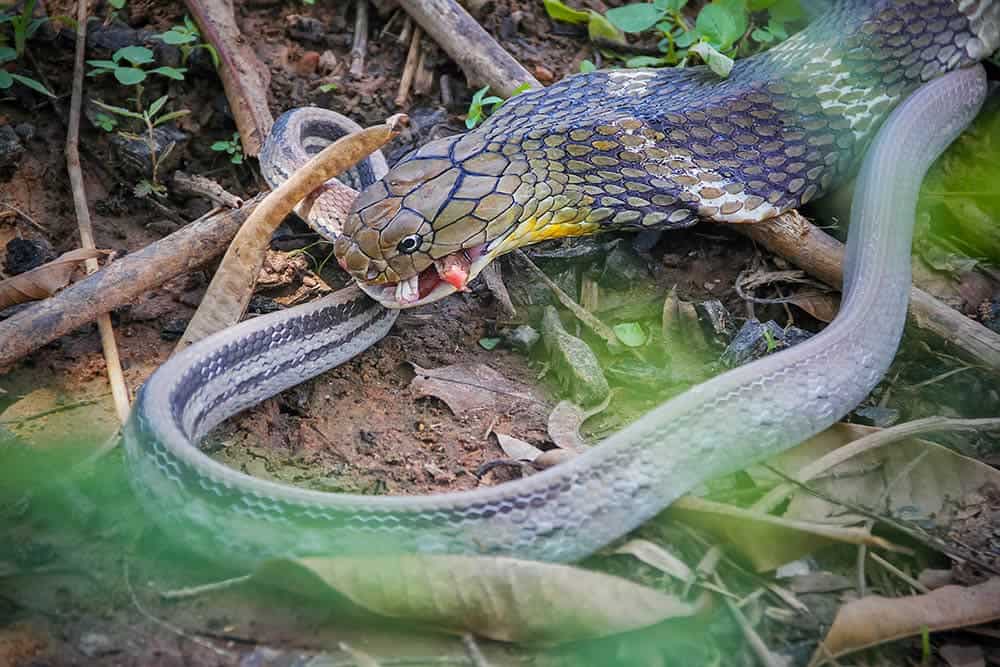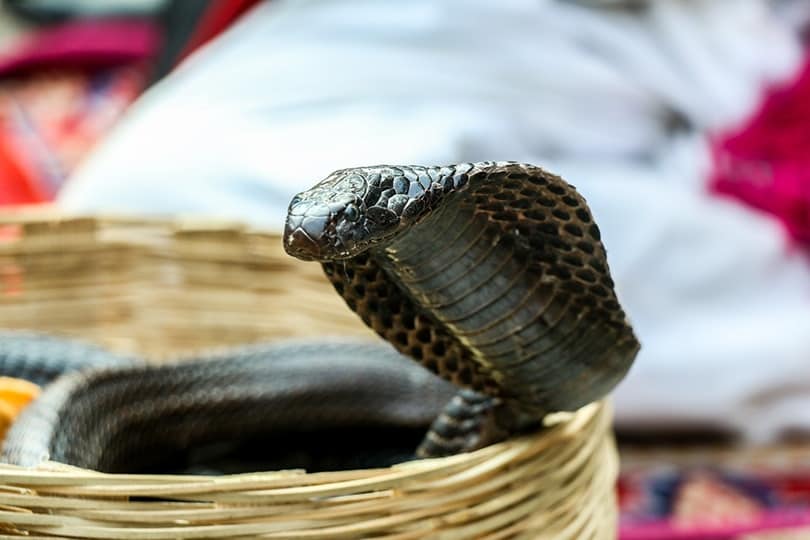The King Cobra’s diet is mainly restricted to other cold-blooded species – including other snakes. This species is a learned hunter, which means that they will develop their eating habits over their lifespan. This trait also means that each snake’s diet may differ depending on their experiences.
Some King Cobras develop an affinity for a particular type of snake, likely because it served as their primary food when they were young. They may refuse any other snake species. If a King Cobra is not introduced to a specific food source when they are young, they may not consume it when they are older.
Most snakes preyed upon by King Cobras are harmless species, such as the rat snake and pythons. These snakes can eat other snakes up to 10 feet long. Of course, the size of their prey will depend on how big they are. Larger, older snakes will consume larger prey animals.
Occasionally, a King Cobra may eat a venomous species – including other King Cobras.
As pets, these snakes are usually raised on mice and rats. If fed this diet from a young age, most accept it readily. They may even refuse to eat other snakes when they reach adulthood.

What Is a King Cobra’s Favorite Food?
In the wild, King Cobras are both learned and opportunistic hunters. When they are younger, they are prone to eat whatever is available. However, as they get older, they may refuse certain foods that they haven’t encountered before.
Most King Cobras live off of a diet consisting of mostly other snakes. They may occasionally eat small mammals, lizards, and birds.
A cobra’s favorite food will differ from snake to snake. While most wild snakes eat other snakes, most pet snakes are raised on mice and rats. If they aren’t fed snakes when they are young, they likely won’t consume them when they are older – even though they’re the primary food source for wild cobras.
Some cobras are extraordinarily picky and may refuse all foods except a particular species of snake.
This factor can make keeping wild cobras as pets difficult. Often, cobras must be bred under human care or captured when they are very young. Otherwise, you don’t know what sort of eating patterns a snake may have.

Do King Cobras Eat Elephants?
No. Elephants are far too large for this snake to eat. For the most part, this snake preys on other snakes that are under 10 feet long.
Smaller snakes have to eat smaller prey animals – while larger snakes may eat animals that are slightly longer than this.
King Cobras typically live on a diet primarily consisting of other snakes. However, occasionally they may eat mammals. Elephants are not included in this, though. They can only consume rather small mammals. Think of things like mice and rats – not elephants.
This misconception probably comes from the fact that an adult King Cobra can kill an elephant in a few hours, thanks to its highly toxic venom. They don’t eat the elephant after it dies. Instead, the venom is essentially a defensive mechanism.
It isn’t that they produce a particularly toxic venom, but they produce a lot of venom. It’s the sheer volume that allows them to kill things much larger than them.

Can a King Cobra Kill a Python?
Yes. They have enough venom to kill creatures much larger than them. If a python disturbs the nest of a female or corners a cobra, they may lash out and bite. One bite is all it would take to kill a python – and the python’s defensive mechanisms likely wouldn’t do much to the King Cobra.
It would be a pretty one-sided fight – in all honesty.
However, it is unlikely that most King Cobras could eat adult pythons. They’re too large for them to wrap their mouth around – literally. Cobras may be able to eat baby and juvenile pythons, as they are much smaller.
There is also the chance that abnormally larger King Cobras may occasionally eat pythons. They mainly prey on other snakes, after all. If a python is small enough to eat, nothing is keeping a King Cobra from attacking one.
What Snakes Do King Cobras Eat?
Whatever they can find. King Cobras are entirely opportunistic when they are young, allowing them to learn to hunt nearly any other snake species.
However, in the wild, their diet is usually confined to a few other species they commonly encounter. For the most part, these include the Indian cobra, banded krait, rat snake, pythons, green whip snake, keelback, banded wolf snake, and Blyth’s reticulated snake.
One study has found that they can hunt pit vipers by following their odor trails. Some may directly hunt and chase these snakes, especially if they are common in their particular range. Not all cobras do this, though, so it appears to be a learned behavior for the most part.

How Do King Cobras Kill Their Prey?
Cobras usually use their venom to bring down their prey. When they’re hunting snakes smaller than them, it works in a matter of minutes. Then, they can eat the prey without risking injury themselves.
In some cases, King Cobras may constrict their prey. They have muscular bodies and can easily constrict smaller mammals, like mice and rats. However, this is somewhat rare. Most snakes prefer to use their venom instead.
There is an increased risk to the snake when it comes to constricting. The prey animal can damage them in the process. The venom is a much safer option in most cases.
One meal can sustain a King Cobra for months. Therefore, they don’t have to hunt very often.

Conclusion
For the most part, King Cobras will eat other large, harmless snakes. These snakes learn as they grow, though, especially when it comes to hunting behavior. Therefore, individuals may be picky about what they eat.
Some cobras may only eat a few other species of snake – refusing other prey items altogether. This trait makes trapping and keeping wild snakes a bit complicated. They might refuse to eat mice and similar animals unless they preyed upon them regularly in the wild.
When kept as pets, many snakes are raised on mice and other rodents. Therefore, they eat them readily. However, they may refuse to eat other snakes if they aren’t fed them until adulthood.
Each snake has their individual hunting patterns and prey items. They may hunt and track down specific species, though many also seem to be opportunistic hunters.
See Also:
- Do King Cobras Make Good Pets? Legality, Moral, Care & More
- 12 Most Dangerous Animals in the World: Statistics to Know
Featured Image Credit by tb-photography, Shutterstock
